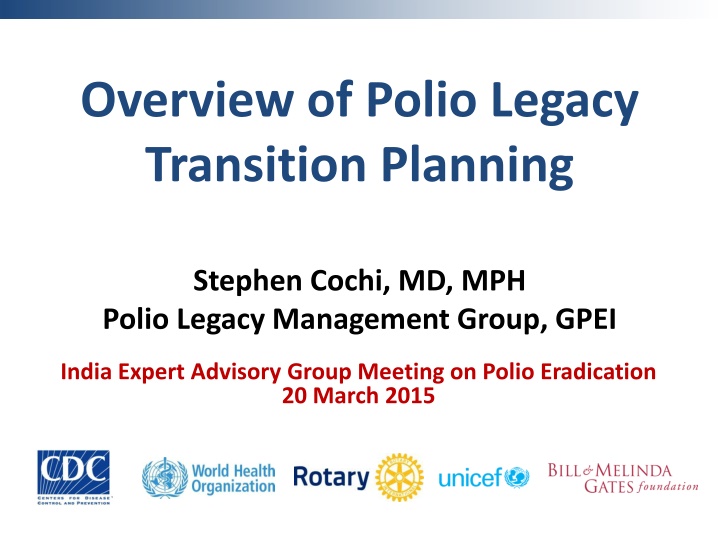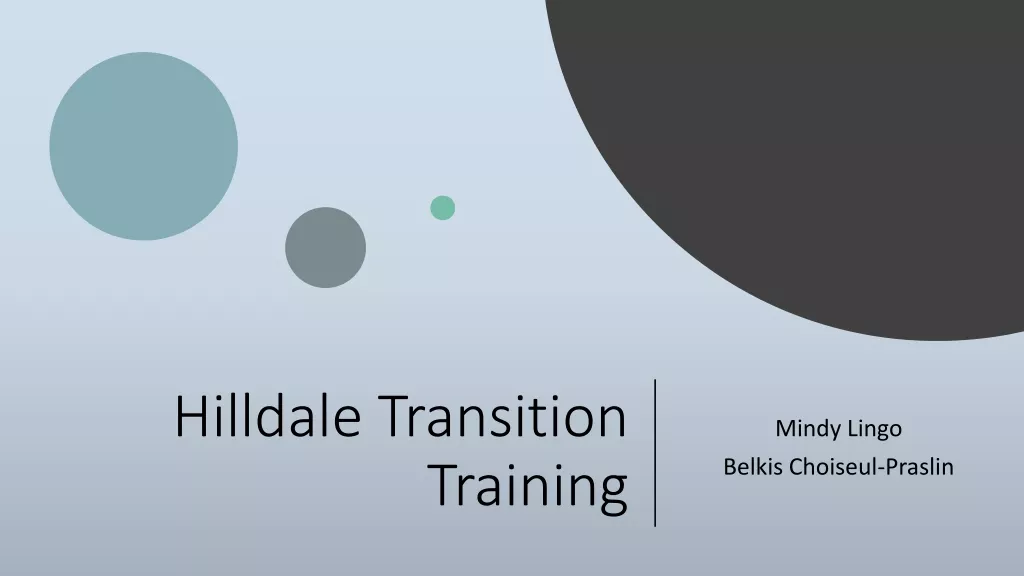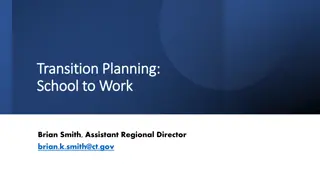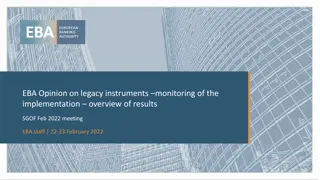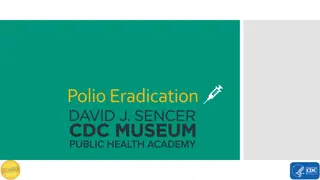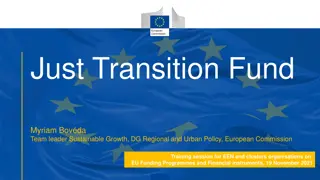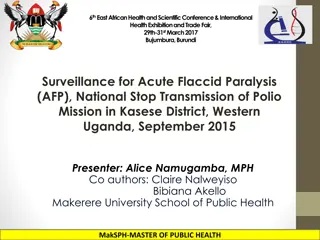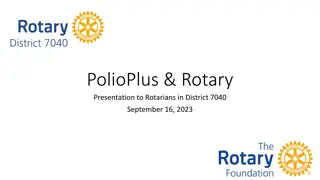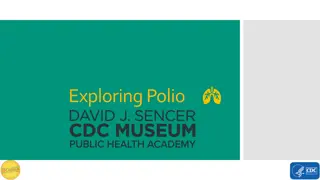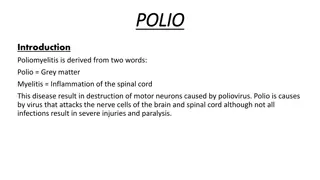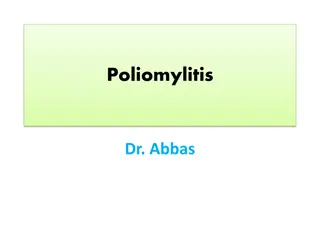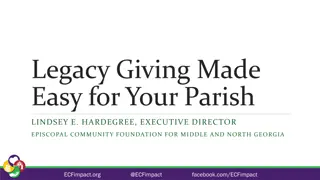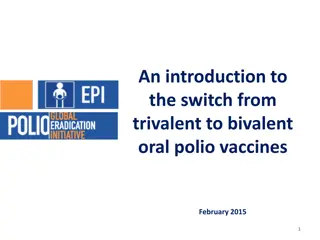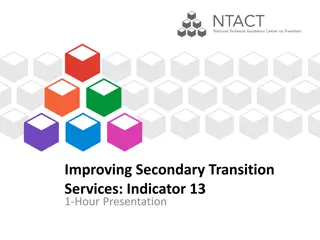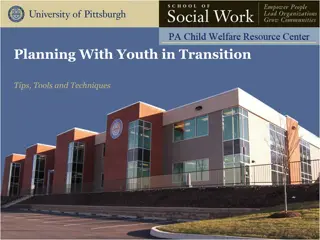Overview of Polio Legacy Transition Planning
This article provides an overview of the Polio Legacy Transition Planning, including main elements such as mainstreaming essential polio functions, capturing and disseminating lessons learned, and transitioning capacities, processes, and assets. It discusses the objectives of legacy planning, lessons learned, global progress in legacy planning, and the development of evidence-based capabilities for future health goals.
Download Presentation

Please find below an Image/Link to download the presentation.
The content on the website is provided AS IS for your information and personal use only. It may not be sold, licensed, or shared on other websites without obtaining consent from the author.If you encounter any issues during the download, it is possible that the publisher has removed the file from their server.
You are allowed to download the files provided on this website for personal or commercial use, subject to the condition that they are used lawfully. All files are the property of their respective owners.
The content on the website is provided AS IS for your information and personal use only. It may not be sold, licensed, or shared on other websites without obtaining consent from the author.
E N D
Presentation Transcript
Overview of Polio Legacy Transition Planning Stephen Cochi, MD, MPH Polio Legacy Management Group, GPEI India Expert Advisory Group Meeting on Polio Eradication 20 March 2015
Polio Endgame Strategic Plan 2013-18 Objective 1 Polio virus detection and interruption Objective 2 Immunization systems strengthening and OPV withdrawal Objective 3 Containment and certification Objective 4 Legacy planning ensure that the investments made to eradicate poliomyelitis contribute to future health goals, through a programme of work to systematically document and transition the knowledge, lessons learned and assets of the Global Polio Eradication Initiative establishment of a comprehensive polio legacy strategic plan by no later than end-2015.
What is Polio Legacy Planning? Legacy Planning: Main Elements 1. Mainstream Essential Polio Functions Define needs up to eradication and beyond Develop plans at country/global level 2. Capture & Disseminate Lessons Learned Through Stakeholder Consultations Documentation and Dissemination mechanisms Map polio program assets & capabilities 3. Transition of capacities, processes, assets Develop Global Legacy Framework Support Development of Regional/Country/Agency Legacy Plans
Legacy Planning: Lessons Learned Lessons Learned: Objectives 1. Document the lessons learned and knowledge generated through >25 years of polio eradication. 2. Ensure that the lessons learned and knowledge generated are shared with other health initiatives. 3. Document how polio infrastructure is currently contributing to other immunization/public health priorities (so-called Legacy in Action ) 4. Each country has unique circumstances and experiences, and would benefit from doing its own Lessons Learned documentation exercise
Global Progress in Legacy Planning Development of an Evidence Base Capabilities, Functions, Assets & Contributions to other priorities Pilot Planning Studies conducted in DRC & Nepal Tolearn how transition planning could work in different settings Draft Transition Guidelines To guide countries in the development of legacy transition plans Draft Global Framework to WHA Outlines proposed phased approach to legacy planning Polio Partners Group Legacy Workshop October 2014 Guidance on direction and content
Survey of country-level polio program managers in 5 countries shows significant time spent supporting other health priorities Estimated time allocation of polio-funded workers by country 100% 5% 0% 3% 2% 5% 6% 1% 4% 5% 6% 2% 1% 0% 1% 3% 0% 1% 1% 3% 3% 5% 9% 3% 4% 4% 5% 7% 1% 2% 1% 1% 1% 2% 3% 1% 1% 2% 4% 4% 2% 0% 1% 75% 18% 19% 28% 26% 28% 23% 11% 20% 50% 11% 12% 14% 21% 54% 25% 44% 43% 42% 39% 31% 0% DRC Nepal India Ethiopia Somalia Overall Polio New vaccine introduction MNCH & nutrition Other diseases & programs Measles & rubella Child health days/weeks Health systems strengthening Routine immunization Sanitation & hygiene Natural disasters & crises 1.Eligible population excludes assistants, secretaries, drivers, clerks, back office support (e.g. HR, finance, IT), and Rotary volunteers Source: Polio Legacy Survey
GPEI program personnel are focused in endemic countries and transitioning countries Endemic country Current/ recent outbreak (2013-2014) Transition (last case 2011-2012) Mid-term polio free (last case 2001-2010) Long term polio free (last case 2000 or before) No GPEI personnel present Headcount 16,982 17,000 10,447 996 407 500 258 0 Endemic Recent outbreak Transition Mid-term free Long- term free Source: GPEI Partner databases
Pilot case study In Nepal, polio-funded IPD division is backbone of surveillance activities and only surveillance for VPDs Immunization Preventable Disease (IPD) program provides surveillance IPD 's network is an integral part of Nepal's public health system IPD represents WHO polio program in Nepal, and is focused mainly on surveillance 15 surveillance officers, 6 technical officers, and 36 support staff IPD is a critical part of the surveillance and data systems in Nepal EWARS: Early warning and reporting system tracks vector borne diseases like malaria and dengue through passive surveillance HMIS: Health Management & Information System (part of government) collects health data from different surveillance networks and hospital sites IPD: Immunization Preventable Disease program provides tracking of vaccine preventable diseases via passive surveillance, active monitoring, and case investigation Originally focused on AFP surveillance, but expanded purview in 2003 to include other diseases (which are still monitored today) AFP Measles and rubella like cases Acute encephalitis syndrome for Japanese encephalitis Neonatal tetanus Without IPD, it is likely the coverage of VPDs in Nepal would significantly degrade "Without IPD, without the SMOs, surveillance would just go away in Nepal" - Government of Nepal official
India--Support other priority health areas Routine immunization Key thematic areas for engagement of polio workforce to support RI identified Intensified Capacity building of frontline workers RI monitoring Accountability through Task Forces Advocacy & Integrated Tagging of HRAs to RI communication session sites Measles Survillance Plan 2013 Measles elimination and Rubella control by 2020 Support provided for expansion of lab based MR surveillance in 25 states Support provided for measles campaigns Laboratory Based Measles/Rubella Surveillance Expansion - India State.shp State.shp Functioning (25 states) 1 2 3 In process (3 state\UTs) To be initiated (7 states\UTs) A 600 0 600 1200 Miles
Legacy Implementation Major Themes National Level Planning: Tailoring approach to country context & linking with existing plans Roles for donors, civil society, stakeholders in the process Global & Regional Priorities: Resources for immunization, VPD surveillance, emergency response Planning & Sequencing To avoid disruption to both polio eradication & core services Sequencing priority countries Cost of legacy planning: Costs of transition planning; sources of funding Maintenance of Essential Polio Functions: Requires separate planning and budgeting
Potential transition timing: Must link with broader organizational timelines for polio asset support RELATIVE TIMELINE - PROPOSED Phase of Transition Planning & Decision Execution Execution Preparation Transition process initiated Assets ready for transition (e.g., funding available, initial trainings conducted) Assets fully operational in new roles (depending on nature of transition) Country transition plan finalized and agreed upon Outcome Estimated Timeline Within 6 months of decision Within 12 months of plan in place 2-5 years after plan in place 12 months ABSOLUTE TIMELINE - INDICATIVE 2014 2015 2016 2017 2018 2019 Global Eradication Certification Stakeholder engagement needed to raise awareness of need for country-level planning Phase Country examples WHA RCMs Transition planning underway DRC Nepal India Legacy transition phase Planning & Decision Preparation & Execution Sudan Ethiopia Somalia S. Sudan Angola Bangladesh Indonesia Myanmar Egypt Chad All other polio- free and recent outbreak Planning & Decision Preparation & Execution Timeline contingent upon eradication status Nigeria Pakistan Afghanistan Current endemics Planning & Decision Preparation & Execution Timeline contingent upon eradication status 11
Legacy Planning: Outcome Legacy Planning: Overall, what would a successful outcome look like? Well-planned and managed conclusion of the GPEI (post- certification) with liabilities and disruption to staff and the programme minimized (HR/Legacy interaction). National & Institutional legacy plans developed, building on the strengths of the GPEI (e.g. access) to benefit generations to come, including: Essential polio functions mainstreamed into ongoing national and institutional structures (e.g. immunization). Resources, lessons and knowledge documented and transitioned to other health priorities as appropriate. Goal: To ensure, that these are the outcomes of the Legacy Planning process, and that we all plan a rational future together.
